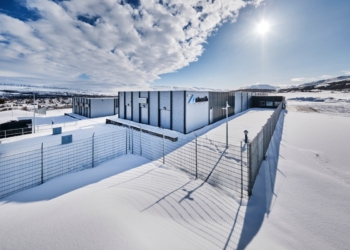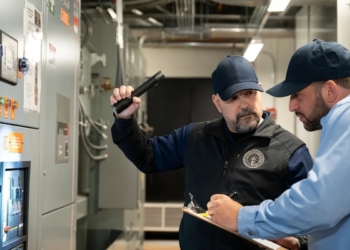‘AI boom triggers 160% data centre power surge’
Author: Joe Peck

Artificial intelligence (AI) is rapidly transforming industries from healthcare to finance, but it comes with a massive energy footprint. Data centres, the backbone of AI, consume huge amounts of power, pushing companies like Meta, Google, and Microsoft to find sustainable solutions.
The complexity and scale of AI models, particularly training large neural networks, require extraordinary computational power, resulting in substantial carbon emissions. For example, maintaining optimal cooling in data centres alone adds significant energy overhead.
This demand is further driven by AI technologies like autonomous vehicles and predictive analytics, which require continuous data processing.
The increased energy use means more burning of coal, oil, and natural gas, which leads to higher emissions. With renewable energy not scaling fast enough, fossil fuels are still the main power source for many data centres. This reliance is especially concerning given projections that power demand in data centres will increase by 160% by 2030, with AI’s energy needs growing rapidly.
Recent headlines show the scale of the challenge: Meta’s landmark 20-year deal to source nuclear power for its Illinois data centres underlines just how critical nuclear energy has become in meeting AI’s soaring electricity demand.
Meanwhile, Google’s agreements to power its data centres with small nuclear reactors and Microsoft’s plans to restart the Three Mile Island plant further highlight how these tech giants are betting big on nuclear to keep AI running without ramping up carbon emissions.
AI boom threatens net zero goals
Data centres, the backbone of AI-powered systems, are among the most energy-intensive facilities in the world. According to the EU Energy Efficiency Directive (EED), operators must now demonstrate continual energy improvements.
This directive aligns with broader regulations like the European Climate Law, which enforces the EU’s target of climate neutrality by 2050. In the UK, schemes like ESOS Phase 3 place additional energy reporting and efficiency requirements on operators.
In Europe, three of the largest economies – the UK, Germany, and France – are at the forefront of efforts to decarbonise their economies and transition to net zero. However, the data centres operating within these countries are facing significant challenges in meeting their decarbonisation and sustainability targets.
Recent findings from a CFP Energy survey highlight that while the majority of data centres in these countries have a net-zero strategy in place, achieving their targets remains elusive.
Net zero strategy adoption
• UK: 94% have a net zero strategy, but 22% are not meeting their decarbonisation and sustainability targets.
• Germany: 90% have a net zero strategy, but 30% are falling short of their targets.
• France: 86% have a net zero strategy, with 14% not hitting their targets.
These statistics underscore a critical reality: despite ambitious targets and high adoption rates of net zero strategies, achieving actual decarbonisation is proving to be a major hurdle.
This trend is particularly concerning as AI demand is poised to increase significantly. If the cost equation remains imbalanced, we may soon face a situation where net zero targets are discarded in favour of meeting the demands of AI, as is already happening in various parts of the world.
The growing reliance on carbon offsetting
With the rapid increase in energy demand from AI, many large tech companies, including Microsoft, are turning to carbon credits and voluntary carbon projects as a means to mitigate their environmental impact.
This has become crucial for companies that simply cannot reduce their energy consumption with current technologies. For instance, Microsoft recently entered into an agreement with Re-Green, committing to offset its emissions through carbon credit purchases and climate-positive projects.
While these measures help compensate for carbon emissions, they highlight a gap in current energy solutions: the technology and power infrastructure are not yet capable of fully supporting the sustainable growth of AI.
Mitigating the environmental footprint of AI and data centres
CFP Energy, a UK-based provider of energy trading, risk management, and environmental services, says it advocates for:
• Sustainable construction — Reducing environmental impact from the outset by using low-embodied-carbon materials in data centre design, which helps cut emissions during both construction and operation.
• Advanced cooling systems — Improving energy efficiency through approaches like liquid cooling, which reduce electricity usage while maintaining optimal performance in increasingly power-intensive environments.
• Voluntary carbon offsetting — Compensating for unavoidable emissions with verified carbon credits. However, recent disputes – such as the suspension of a Kenyan soil-carbon project involving Netflix and Meta – reveal serious concerns about transparency, community impact, and oversight. These events highlight the need for stronger governance and ethical standards across the voluntary carbon market.
• Collaboration — Developing joint solutions with governments, utilities, and technology partners – including renewable energy agreements and efficient hardware – to drive systemic progress and ensure sustainable AI infrastructure at scale.
A legislative push towards sustainability
The policy environment is rapidly evolving, with regulations like the Digital Operations Resilience Act and the Corporate Sustainability Reporting Directive mandating transparency on emissions and energy efficiency.
Operators who fail to adapt risk falling behind, both in compliance and customer retention. Businesses increasingly prioritise sustainability, and carbon-conscious customers are gravitating towards providers with robust strategies for renewable energy adoption and operational efficiency.
George Brown, Sustainability Researcher for Data Centres at CFP, comments, “The climate emergency is a clear signal for change, and we need sustainable solutions now.
“While AI is driving innovation and is critical to our digital future, it – and the data centres that support it – must align with the environmental imperatives of the 21st century.
“Data centres need to operate in a way that supports, rather than undermines, our environmental goals. Despite widespread net zero strategies, many data centres are failing to meet their targets.
“At CFP Energy, we believe collaboration is key. Tech companies, governments, and energy providers must work together. Sustainable construction, advanced cooling, and voluntary carbon offsetting are essential.
“Carbon credits are a temporary solution, but long-term investments in renewables and efficiency must accelerate.
“Regulations are pushing for greater transparency and efficiency, and businesses that don’t adapt risk penalties and losing eco-conscious customers. AI’s growth must align with sustainability, and CFP Energy is committed to leading the transition.
“Every stakeholder – governments, businesses, and consumers – must work together to ensure a sustainable digital landscape. Each has a role to play in ensuring that our digital future is also a sustainable one.”








